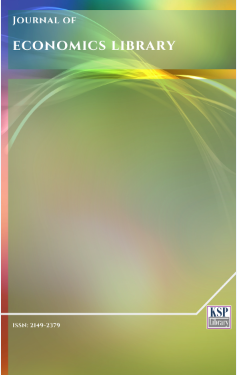Physical Infrastructures and Attractiveness of Private Capital in Sub-Saharan African (SSA) Countries
Abstract
References
Alfaro, L., Kalemli-Ozcan, S. and Vadym, V. (2003). Why doesn’t Capital Flow from Rich to Poor Countries, (Forthcoming) Review of Economics and Statistics.
Alfaro, L., Kalemli-Ozcan, S. Vadym, V. (2005). Capital Flows in a Globalized World: The Role of Policies and Institutions, NBER Working Paper No. 11696.
Aschauer, D.A. (1989) Does Public Capital Crowd out Private Capital?, Journal of Monetary Economics, 24(2), 171-188.
Asiedu, E. (2002). On the Determinants of Foreign Direct Investment to Developing Countries: Is Africa Different?, World Development, 30(1), 107-139.
Asiedu, E. (2006). Foreign Direct Investment in Africa: The Role of Natural Resources, Market Size, Government Policy, Institutions and Political Instability. The World Economy, 29(1), 63-77.
Asiedu, E. & Gyimah-Brempong, K. (2007). Effect of the Liberalization of Investment Policies on Employment and Investment of Multinational Corporations in Africa, WIDER Working Paper, no. 69.
Bénassy-Quéré, A. & Fontagné, L. (2001). Exchange-rate Strategies in the Competition for Attracting Foreign Direct Investment”, Journal of the Japanese and International Economies, 51(2), 178-198.
Bénassy-Quéré, A., Coupet, M., & Mayer, T. (2007). Institutional Determinants of Foreign Direct Investment, World Economy, 30(2), 764-82.
Calderón, C., & Servén, L. (2004). Trends in Infrastructure in Latin America, 1980-2001, World Bank Research Paper, no 269. dialnet.unirioja.es.
Calvo, G., Leiderman, L., & Reinhart, C. (1996). Inflows of Capital to Developing Countries in the 1990’s, Journal of Economic Perspectives, 10(2), 123-139.
Coval, J. D. & Moskowitz J. (2001). The Geography of Investment: Informed Trading and Asset Prices, Journal of Political Economy, 109 (4), 811-541.
Dupuch, S. (2001). Les déterminants des flux d'IDE intra-européens, Centre d'Économie de Paris-Nord (CEPN) CNRS-UMR - univ-paris13.fr
Escribano, A. & Guasch, J. L. (2005). Assessing the Impact of the Investment Climate on Productivity Using Firm-Level Data: Methodology and the Cases of Guatemala, Honduras, and Nicaragua, World Bank Policy Research Working Paper No. 3621
Ferrucci, G., Herzberg, V., Soussa, F., & Taylor, A. (2004). Understanding Capital Flows to Emerging Market Economies, Financial Stability Review, 16, 89-97.
Garcia-Mila, T., McGuire, T. J., & Porter, R. H. (1996). The Effect of Public Capital in State-level Production Functions Reconsidered, The Review of Economics and Statistics, 7(1), 2-16.
Gastanaga, V., Nugent, J.B., & Pashamova, B. (1998). Host Country Reforms and FDI Inflows: How Much Difference Do They Make?, World Development , 26(7), 1299-1314.
Gramlich, E. M. (1994). Infrastructure Investment: a Review Essay, Journal of Economic Literature, 32(3), 1176-1196.
Haussmann, R. & Fernandez-Arias, E. (2000). Foreign Direct Investment: Good Cholesterol, Inter-American Development Bank Working Paper, no. 417.
Jenkins, C. & Thomas, L. (2002). Foreign Direct Investment in Southern Africa: Determinants, Characteristics and Implications for Economic Growth and Poverty Alleviation”, sarpn.org
Kandiero, T. & Chitiga, M. (2003). Trade openness and Foreign Direct Investment in Africa: Economics, South African Journal of Economic and Management Sciences, 9(3), 355-370.
Kim, Y. (2000). Causes of Capital Flows in Development Countries, Journal of International Money and Finance, 19(2), 235-253.
Kinda, T. (2008). Infrastructure et flux de capitaux privés vers les pays en développement, Revue économique, 59(3), 537-549.
Kumar, N. (2002). Infrastructure Availability, Foreign Direct Investment Inflows and their Export-orientation: A Cross-country Exploration, RIS Discussion Paper No. 26.
Levine, R. (1997). Financial Development and Economic Growth: Views and Agenda, Journal of Economic Literature, 35(2), 688-726.
Levine, R. (2005). Finance and Growth: Theory and Evidence, Handbook of Economic Growth, 1(part A), 865-934.
Loree, D. W. & Guisinger, S. E. (1995). Policy and Non-Policy Determinants of U.S Equity Foreign Direct Investment, Journal of International Business Studies, 26(2), 281-298.
Lucas, R.E. (1990). Why Doesn’t Capital Flow from Rich to Poor Countries?, American Economic Review, 80(2), 92-96.
Maleck, R. (2014). Lean Principals Application in Public-Private Partnership Project Procurement, etd. Ohiolink.edu, May 2014.
Montiel, P. J. (2006) Obstacles to Investments in Africa: Explaining the Lucas Paradox”, Presented at the high-level seminar Realizing, The Potential for Profitable Investment in Africa.
Ngowi, H.P. (2001). Can Africa Increase Its Global Share of Foreign Direct Investment (FDI), West Africa Review, 2(2), 1-22.
Nunnenkamp, P. (2002). Determinants of FDI in Developing Countries: has Globalization Changed the Rules of the Game?, Working Paper, Kieler Arbeitspapiere, No. 1122-econstor.eu
OCDE (2002), “L’investissement direct étranger au service du développement: optimiser les avantages, minimiser les coûts, synthèse”, OCDE
Quazi (2007). Economic Freedom and Foreign Direct Investment in East Asia, Journal of the Asia Pacific Economy, 12(3), 329-344.
Ramanmurti, R. & Doh, J. (2004). Rethinking Foreign Infrastructure Investment in Developing Countries, Journal of World Business, 39(2), 52-58.
Reinhart, C., & Rogoff, K. (2004). Serial Default and the “Paradox” of Rich to Poor Capital Flows, American Economic Review, 94(2), 52-58.
Root, F. and Ahmed, A. (1979). Empirical Determinants of Manufacturing Direct Investment in Developing Countries, Economic Development and Cultural Change, 27(4), 751-767.
Portes, R. & Doh J. (2005). The Determinants of Cross-Border Equity Transaction Flows, Journal of International Economics, 65(2), 151-167.
Seetenah, B., & Khadaroo, A. J. (2007). Foreign Direct Investment and Growth: New Evidences from Sub-Saharan African countries, Economic Development Africa, case.ox.ac.uk
Teulon, F. (2014). La critique de Lucas: Robert Lucas et la politique économique, Working Paper, no 567, Department of Research, Ipag Business School.
DOI: http://dx.doi.org/10.1453/jel.v1i1.159
Refbacks
- There are currently no refbacks.
.......................................................................................................................................................................................................................................................................................................................................
Journal of Economics Library - J. Econ. Lib. - JEL - www.kspjournals.org
ISSN: 2149-2379
Editor: [email protected] Secretarial: [email protected] Istanbul - Turkey.
Copyright © KSP Library

